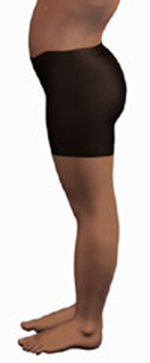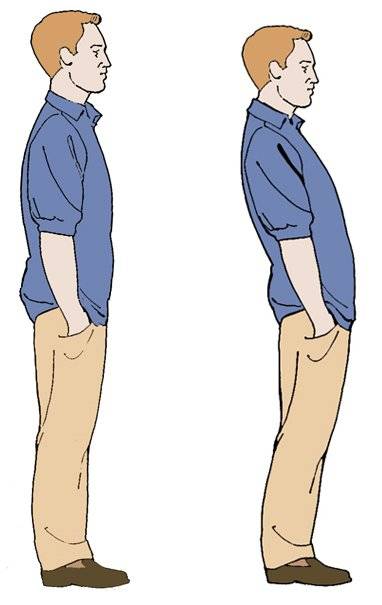By David McGill
-
Do you still experience back pain despite exercising regularly?
-
Though massaged, manipulated and temporarily relieved by treatment, does your back pain keep recurring?
-
Despite good flexibility, advice and effort to develop ‘core strength’, does your upper or lower back repeatedly suffer?
Back pain. A lack of ‘core abdominal strength’. Something we as exercise therapists and you the general public repeatedly hear as the sole cause and subsequent solution to back pain. Contrary to this however and regardless of good ‘core strength,’ there are many more causative factors which will prompt and prolong back pain. Unfortunately though, these are often overlooked and unaddressed by many therapists or exercise professionals.
Lower back pain is estimated to affect between 60% to 80% of the population at some point in their lives. The cost of back pain is approximately £500 million annually to the National Health Service in the UK. In the UK, 2.5 million people have back pain every day of the year which results in a total cost of £12.3 billion (22% of UK healthcare expenditure). In the UK, back problems are the leading cause of disability with nearly 119 million days a year lost (Paincommunitycentre.org 2016). Back pain can be felt and suffered in any region of the spine, from the lower ‘lumbar’ region to the neck and shoulder-blade area.
There are in excess of 10 other musculoskeletal causes of upper and lower back pain. Rather than firstly identifying and addressing the root cause of the pain with assessments and corrective exercises, the site where pain is ultimately felt is typically treated by many therapists, offering temporary relief yet repeated future visits for the patient. With detailed client assessments, selective massage and essential corrective exercises, we at Bodyrefine identify and effectively address these causative factors, working prehabilitatively to prevent them recurring, ultimately improving physical mobility, ability and the quality of a patient’s life.

Tight thigh muscles are just one example of the many possible causes of back pain and a catalyst for eventual injury through disc compression in the lower spine. These muscles originate from and attach to the front of the hips. Consequently, if overworked and/or understretched, these muscles prompt an increased forward hip tilt (see diagram) and a chain reaction, excessive concave curvature of the lower spine (hyperlordosis). By curving excessively, this compresses, stresses and damages the delicate intervertebral discs located between the bones of the lower spine. This increased forward hip tilt also prompts a weakening and inevitable protrusion of the lower tummy/abdominals which will remain despite stomach crunches, 100’s or other such exercises intended to flatten it. So, you may want the question and rethink the purpose and potential side effects next time your trainer, boot camp or cross fit instructor prompts you to do endless, excessive lunges, squats and kettle bell swings which merely over-work the thighs.
Over-stretched hamstrings are another lower-back, pain-prompting catalyst. Contrary to popular belief and misguidance when stretching, too much flexibility in these muscles is actually bad for the back, as well as the knees. Together with movement, hamstrings serve an essential role (along with the buttock muscles) in holding our body upright, maintaining good postural alignment. Excess flexibility of the hamstrings lengthens them, prompting the body to sway or lean forward (see diagram) and the knees to lock backwards (hyperextension). To counteract this and maintain balance, the upper body has to lean backwards, unable to remain in this forward-swaying posture. This ultimately results in increased muscle tightness, compression, concave curvature of and subsequent stress and damage to the lower (lumbar) spine and its delicate components comprising of bones, discs and nerves.

Thoracic hyperkyphosis. In Layman’s terms this means excessively rounded shoulders. Often caused by desk work or prolonged driving, certain exercises (such as sit-ups, 100’s, cross-crunches and roll-ups) together with imbalanced exercise programmes (where the chest, latissimus dorsi and upper trapezius muscles are over-worked) can also cause or otherwise exacerbate this postural misalignment. For every inch of forward head movement, this increases the weight, load and stress upon the spine by an additional 4-5kg (Kapandii 2016). The human head weighs about 5-6kg. As the head bends forward and down, the weight on the cervical spine (neck bones) begins to increase. At a 15-degree angle, this weight is about 12kg, at 30 degrees it’s 18kg, at 45 degrees it’s 22kg, and at 60 degrees it’s 27kg. That’s the burden that comes with staring down at a IPhone, Smartphone, IPad or tablet, which many people do each day for hours at a time, according to research published by Kenneth Hansraj in the National Library of Medicine. Add to this some excessively rounded shoulders and a subsequent lack of rotational mobility in this (thoracic) region of the spine and the workload and subsequent stress upon the upper and particularly lower spine will drastically increase.
DBS (Dormant Bottom Syndrome). Recently appearing in media publications, this revamped, revised term simply means weak, inactive muscles of the ‘gluteus maximus’, otherwise known by many as the buttocks or bottom. Unfortunately, by many people in today’s society sitting for prolonged periods working at desks or perched on sofas for hours recreationally in front of the television, the bottom feels obsolete and excluded from physical activity. Due to its lack of use and involvement in upright activity it becomes inactive, work-shy and dormant. Consequently it no longer fulfils its important role as the strongest muscle in the body, essential for squatting, lifting, walking, running and standing upright with good stead. This increases the workload on its counterparts, the lower back and hamstrings, both of which tighten and eventually suffer from working excessively. Rather than addressing and reactivating this work-shy ‘derriere,’ the lower back and hamstrings are often just merely massaged or over-stretched by many therapists. For those who try to strengthen this dormant bottom using squats (which do indeed have the right intention), the brain will bypass the bottom, recruiting the already tight, overworked muscles instead, which will exacerbate the problem. This process is known as ‘synergistic dominance’ where muscles intended to support and assist key ones in major, whole body movements are instead overloaded with the greater responsibility, doubling their workload and subsequent suffering.
Do you run regularly, hike or walk recreationally? Key muscles essential to correct alignment, gait and movement during running and walking are often weak and inactive in many gym-goers. Regardless of their increased stamina, aerobic fitness and mileage, we often see this in many patients who are established, experienced runners, some of whom are training for marathons. Such muscles, essential to running, are intended to work in conjunction with the lower back, sharing the load involved in the complex, demanding biomechanical movement and musculoskeletal involvement in running. Many runners are oblivious to this, yet certainly not of the pain they feel which is caused by this. If dormant and unaddressed, these muscles place increased stress and workload upon the back. Massage or manipulation doesn’t suffice in permanently rectifying and preventing this problem recurring. Rather than prescribing corrective exercises to adequately prepare the runner for the demands of this activity, most exercise professionals place people on treadmills in their first session, unaware of the dormant, inactive muscles essential for running and walking and the injury or pain this will otherwise eventually lead to.
Despite advice from experts, many exercisers ignore this and continue to do antiquated abdominal exercises proven to be physically damaging and detrimental. Dr. Stuart McGill Ph.D, a leading professor of spinal biomechanics at the University of Waterloo, Canada and a world renowned expert in low back disorders has, over decades, researched how the low back functions and how it can become injured. He’s established that sit-ups, roll-ups and similar ‘spinal flexion’ exercises place 3,300 Newtons (the equivalent of 340 kg) of compressive force on the spine when bent/ hunched or rounded in spinal flexion exercises. These forces on the spine can squeeze a bent disc’s nucleus (located between the spinal bones/ vertebrae as shown in the diagram) to the point that it bulges, pressing on nerves, causing back pain, and potentially leading to a herniated, inflamed, swollen disc/s. “We stopped teaching people to do crunches a long, long time ago,” says Dr. Richard Guyer, president of the Texas Back Institute. That’s because the “full spinal flexion” movement or the actual “crunch” part of crunches puts an unhealthy strain on your back at its weakest point. The section with the most nerves (and most potential for nerve damage) is in the back of the spine, which is the very part that bends and strains during a sit-up or similar spinal flexion exercise/ movement.

A sit-up, crunch, roll-up or ‘100’ is merely a back-bend or spinal flexion standing upright (see diagram), yet done in a lying position. “When people do these types of exercises, they are replicating a very potent injury mechanism on their back,” says McGill. “Every time they bend it they are one repetition closer to damaging the disc.” According to McGill, “if you do enough sit-ups you’re going to hurt your back. Our backs only have so many bending cycles in them. Everyone is different based on genetics, but our backs are like wire coat hangers. Bend that coat hanger back and forth so many times and it’s going to weaken and finally break.”

Most desk or driving workers spend 8-13 hours per day sitting slumped with shoulders hunched, legs and hips elevated, with their heads down staring at screens. If we were to take a step back and view this, it’s almost identical to the foetal position. The stress and misalignment caused to the spine by adopting this posture in work or recreation is alarming, detrimental and degenerative enough to the spine. Why therefore do exercise professionals and therapists still encourage people to do abdominal/stomach exercises involving movements and positions which merely replicate and exacerbate this unfavourable, detrimental posture?
As corrective exercise therapists and specialist trainers, we at Bodyrefine frequently encounter and assist patients. These patients range from regular committed exercisers (some of whom surprisingly include G.P’s, surgeons, physiotherapists, Yoga and Pilates teachers, marathon runners) to non-exercisers, yet all of whom are looking for a permanent solution to their suffering from back pain, rather than temporary pain relief from treatment received elsewhere.
We precede any necessary massage treatment or corrective exercise prescription with a comprehensive postural and musculoskeletal assessment. This identifies the many causative factors of back pain, applicable to the patient, which are to be addressed. The corrective and progressive, integrative exercises we subsequently prescribe our clients (along with any complementary selective stretching or massage) purposefully addresses, rectifies and prevents the causative musculoskeletal issues for which the back (as well as shoulders, hips and knees) bears the load and painfully suffers.
Endorsed by spinal surgeons, osteopaths and chiropractors whose patients they refer to us for preventative, prehabilitative exercise assistance, we assist a variety of clients in terms of age and level of physical recreational activity.
